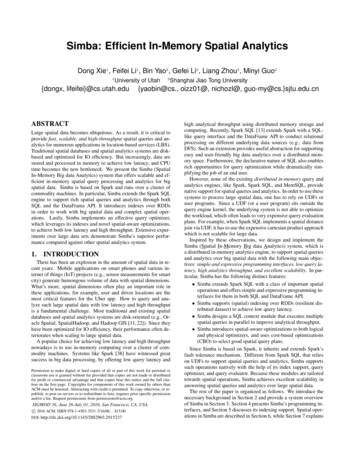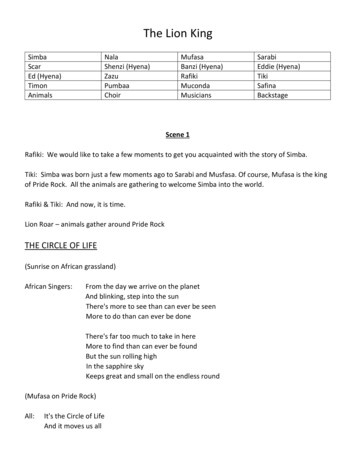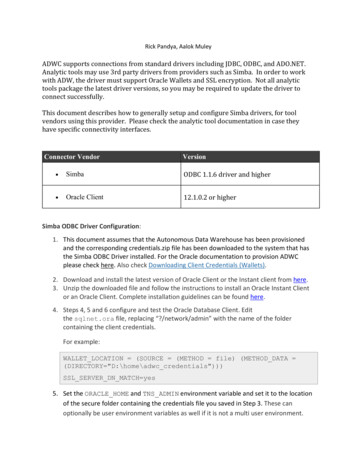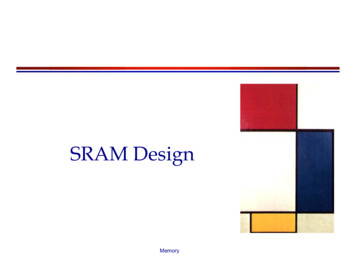
Transcription
Simba: Efficient In-Memory Spatial AnalyticsDong Xie1 , Feifei Li1 , Bin Yao2 , Gefei Li2 , Liang Zhou2 , Minyi Guo21University of Utah{dongx, lifeifei}@cs.utah.edu2Shanghai Jiao Tong University{yaobin@cs., oizz01@, nichozl@, guo-my@cs.}sjtu.edu.cnABSTRACTLarge spatial data becomes ubiquitous. As a result, it is critical toprovide fast, scalable, and high-throughput spatial queries and analytics for numerous applications in location-based services (LBS).Traditional spatial databases and spatial analytics systems are diskbased and optimized for IO efficiency. But increasingly, data arestored and processed in memory to achieve low latency, and CPUtime becomes the new bottleneck. We present the Simba (SpatialIn-Memory Big data Analytics) system that offers scalable and efficient in-memory spatial query processing and analytics for bigspatial data. Simba is based on Spark and runs over a cluster ofcommodity machines. In particular, Simba extends the Spark SQLengine to support rich spatial queries and analytics through bothSQL and the DataFrame API. It introduces indexes over RDDsin order to work with big spatial data and complex spatial operations. Lastly, Simba implements an effective query optimizer,which leverages its indexes and novel spatial-aware optimizations,to achieve both low latency and high throughput. Extensive experiments over large data sets demonstrate Simba’s superior performance compared against other spatial analytics system.1.INTRODUCTIONThere has been an explosion in the amount of spatial data in recent years. Mobile applications on smart phones and various internet of things (IoT) projects (e.g., sensor measurements for smartcity) generate humongous volume of data with spatial dimensions.What’s more, spatial dimensions often play an important role inthese applications, for example, user and driver locations are themost critical features for the Uber app. How to query and analyze such large spatial data with low latency and high throughputis a fundamental challenge. Most traditional and existing spatialdatabases and spatial analytics systems are disk-oriented (e.g., Oracle Spatial, SpatialHadoop, and Hadoop GIS [11, 22]). Since theyhave been optimized for IO efficiency, their performance often deteriorates when scaling to large spatial data.A popular choice for achieving low latency and high throughputnowadays is to use in-memory computing over a cluster of commodity machines. Systems like Spark [38] have witnessed greatsuccess in big data processing, by offering low query latency andPermission to make digital or hard copies of all or part of this work for personal orclassroom use is granted without fee provided that copies are not made or distributedfor profit or commercial advantage and that copies bear this notice and the full citation on the first page. Copyrights for components of this work owned by others thanACM must be honored. Abstracting with credit is permitted. To copy otherwise, or republish, to post on servers or to redistribute to lists, requires prior specific permissionand/or a fee. Request permissions from permissions@acm.org.SIGMOD’16, June 26-July 01, 2016, San Francisco, CA, USAc 2016 ACM. ISBN 978-1-4503-3531-7/16/06. . . 15.00DOI: http://dx.doi.org/10.1145/2882903.2915237high analytical throughput using distributed memory storage andcomputing. Recently, Spark SQL [13] extends Spark with a SQLlike query interface and the DataFrame API to conduct relationalprocessing on different underlying data sources (e.g., data fromDFS). Such an extension provides useful abstraction for supportingeasy and user-friendly big data analytics over a distributed memory space. Furthermore, the declarative nature of SQL also enablesrich opportunities for query optimization while dramatically simplifying the job of an end user.However, none of the existing distributed in-memory query andanalytics engines, like Spark, Spark SQL, and MemSQL, providenative support for spatial queries and analytics. In order to use thesesystems to process large spatial data, one has to rely on UDFs oruser programs. Since a UDF (or a user program) sits outside thequery engine kernel, the underlying system is not able to optimizethe workload, which often leads to very expensive query evaluationplans. For example, when Spark SQL implements a spatial distancejoin via UDF, it has to use the expensive cartesian product approachwhich is not scalable for large data.Inspired by these observations, we design and implement theSimba (Spatial In-Memory Big data Analytics) system, which isa distributed in-memory analytics engine, to support spatial queriesand analytics over big spatial data with the following main objectives: simple and expressive programming interfaces, low query latency, high analytics throughput, and excellent scalability. In particular, Simba has the following distinct features: Simba extends Spark SQL with a class of important spatialoperations and offers simple and expressive programming interfaces for them in both SQL and DataFrame API. Simba supports (spatial) indexing over RDDs (resilient distributed dataset) to achieve low query latency. Simba designs a SQL context module that executes multiplespatial queries in parallel to improve analytical throughput. Simba introduces spatial-aware optimizations to both logicaland physical optimizers, and uses cost-based optimizations(CBO) to select good spatial query plans.Since Simba is based on Spark, it inherits and extends Spark’sfault tolerance mechanism. Different from Spark SQL that relieson UDFs to support spatial queries and analytics, Simba supportssuch operations natively with the help of its index support, queryoptimizer, and query evaluator. Because these modules are tailoredtowards spatial operations, Simba achieves excellent scalability inanswering spatial queries and analytics over large spatial data.The rest of the paper is organized as follows. We introduce thenecessary background in Section 2 and provide a system overviewof Simba in Section 3. Section 4 presents Simba’s programming interfaces, and Section 5 discusses its indexing support. Spatial operations in Simba are described in Section 6, while Section 7 explains
Simba’s query optimizer and fault tolerance mechanism. Extensiveexperimental results over large real data sets are presented in Section 8. Section 9 summarizes the related work in addition to thosediscussed in Section 2, and the paper is concluded in Section 10.2. BACKGROUND AND RELATED SYSTEMS2.1 Spark OverviewApache Spark [38] is a general-purpose, widely-used cluster computing engine for big data processing, with APIs in Scala, Java andPython. Since its inception, a rich ecosystem based on Spark forin-memory big data analytics has been built, including libraries forstreaming, graph processing, and machine learning [6].Spark provides an efficient abstraction for in-memory clustercomputing called Resilient Distributed Datasets (RDDs). Each RDDis a distributed collection of Java or Python objects partitioned acrossa cluster. Users can manipulate RDDs through the functional programming APIs (e.g. map, filter, reduce) provided by Spark,which take functions in the programming language and ship themto other nodes on the cluster. For instance, we can count lines containing “ERROR” in a text file with the following scala code:lines spark.textFile("hdfs://.")errors lines.filter(l l.contains("ERROR"))println(errors.count())This example creates an RDD of strings called lines by reading an HDFS file, and uses filter operation to obtain anotherRDD errors which consists of the lines containing “ERROR”only. Lastly, a count is performed on errors for output.RDDs are fault-tolerant as Spark can recover lost data using lineage graphs by rerunning operations to rebuild missing partitions.RDDs can also be cached in memory or made persistent on disk explicitly to accelerate data reusing and support iteration [38]. RDDsare evaluated lazily. Each RDD actually represents a “logical plan”to compute a dataset, which consists of one or more “transformations” on the original input RDD, rather than the physical, materialized data itself. Spark will wait until certain output operations(known as “action”), such as collect, to launch a computation. This allows the engine to do some simple optimizations, suchas pipelining operations. Back to the example above, Spark willpipeline reading lines from the HDFS file with applying the filterand counting records. Thanks to this feature, Spark never needsto materialize intermediate lines and errors results. Thoughsuch optimization is extremely useful, it is also limited because theengine does not understand the structure of data in RDDs (that canbe arbitrary Java/Python objects) or the semantics of user functions(which may contain arbitrary codes and logic).2.2Spark SQL OverviewSpark SQL [13] integrates relational processing with Spark’sfunctional programming API. Built with experience from its predecessor Shark [35], Spark SQL leverages the benefits of relationalprocessing (e.g. declarative queries and optimized storage), and allows users to call other analytics libraries in Spark (e.g. SparkMLfor machine learning) through its DataFrame API.Spark SQL can perform relational operations on both externaldata sources (e.g. JSON, Parquet [5] and Avro [4]) and Spark’sbuilt-in distributed collections (i.e., RDDs). Meanwhile, it evaluates operations lazily to get more optimization opportunities. SparkSQL introduces a highly extensible optimizer called Catalyst, whichmakes it easy to add data sources, optimization rules, and data typesfor different application domains such as machine learning.Spark SQL is a full-fledged query engine based on the underlying Spark core. It makes Spark accessible to a wider user base andoffers powerful query execution and optimization planning.Despite the rich support of relational style processing, SparkSQL does not perform well on spatial queries over multi-dimensionaldata. Expressing spatial queries is inconvenient or even impossible.For instance, a relational query as below is needed to express a 10nearest neighbor query for a query point q (3.0, 2.0) from thetable point1 (that contains a set of 2D points):SELECT * FROM point1ORDERED BY (point1.x - 3.0) * (point1.x - 3.0) (point1.y - 2.0) * (point1.y - 2.0)LIMIT 10.To make the matter worse, if we want to retrieve (or do analysesover) the intersection of results from multiple kNN queries, morecomplex expressions such as nested sub-queries will be involved.In addition, it is impossible to express a kNN join succinctly overtwo tables in a single Spark SQL query. Another important observation is that most operations in Spark SQL require scanning theentire RDDs. This is a big overhead since most computations maynot actually contribute to the final results. Lastly, Spark SQL doesnot support optimizations for spatial analytics.2.3Cluster-Based Spatial Analytics SystemsThere exists a number of systems that support spatial queries andanalytics over distributed spatial data using a cluster of commoditymachines. We will review them briefly next.Hadoop based system. SpatialHadoop [22] is an extension of theMapReduce framework [18], based on Hadoop, with native supportfor spatial data. It enriches Hadoop with spatial data awareness inlanguage, storage, MapReduce, and operation layers. In the language layer, it provides an extension to Pig [30], called Pigeon [21],which adds spatial data types, functions and operations as UDFs inPig Latin Language. In the storage layer, SpatialHadoop adapts traditional spatial index structures, such as Grid, R-tree and R -tree,to a two-level index framework. In the MapReduce layer, SpatialHadoop extends MapReduce API with two new components, SpatialFileSplitter and SpatialRecordReader, for efficient and scalablespatial data processing. In the operation layer, SpatialHadoop isequipped with several predefined spatial operations including boxrange queries, k nearest neighbor (kNN) queries and spatial joinsover geometric objects using conditions such as within and intersect. However, only two-dimensional data is supported, and operations such as circle range queries and kNN joins are not supportedas well (according to the latest open-sourced version of SpatialHadoop). SpatialHadoop does have good support on different geometric objects, e.g. segments and polygons, and operations overthem, e.g. generating convex hulls and skylines, which makes it adistributed geometric data analytics system over MapReduce [20].Hadoop GIS [11] is a scalable and high performance spatial datawarehousing system for running large scale spatial queries on Hadoop.It is available as a set of libraries for processing spatial queries andan integrated software package in Hive [33]. In its latest version,the SATO framework [34] has been adopted to provide differentpartition and indexing approaches. However, Hadoop GIS onlysupports data up to two dimensions and two query types: box rangequeries and spatial joins over geometric objects with predicates likewithind (within distance).GeoSpark. GeoSpark [37] extends Spark for processing spatialdata. It provides a new abstraction called Spatial Resilient Distributed Datasets (SRDDs) and a few spatial operations. GeoSparksupports range queries, kNN queries, and spatial joins over SRDDs.Besides, it allows an index (e.g. quad-trees and R-trees) to be theobject inside each local RDD partition. Note that Spark allowsdevelopers to build RDDs over objects of any user-defined typesoutside Spark kernel. Thus essentially, an SRDD simply encapsu-
Core FeaturesData dimensionsSQLDataFrame APISpatial indexingIn-memoryQuery plannerQuery optimizerConcurrentquery executionSimbaGeoSpark SpatialSpark SpatialHadoop Hadoop GISmultipled 2d 2d 2d 2X Pigeon X R-treeR-/quad-tree grid/kd-treegrid/R-treeSATOXXX X X X thread pool in user-leveluser-leveluser-leveluser-levelquery engineprocessprocessprocessprocessquery operation supportBox range queryXXXXXCircle range queryXXX k nearest neighborXXonly 1NNX Distance joinXXXvia spatial joinXkNN joinX Geometric object 1XXXXCompound queryX X Table 1: Comparing Simba against other systems.lates an RDD of spatial objects (which can be points, polygons orcircles) with some common geometry operations (e.g. calculatingthe MBR of its elements). Moreover, even though GeoSpark is ableto use index to accelerate query processing within each SRDD partition, it does not support flexible global index inside the kernel.GeoSpark only supports two-dimensional data, and more importantly, it can only deal with spatial coordinates and does not allowadditional attributes in spatial objects (e.g. strings for description).In other words, GeoSpark is a library running on top of and outsideSpark without a query engine. Thus, GeoSpark does not provide auser-friendly programming interface like SQL or the DataFrameAPI, and has neither query planner nor query optimizer.SpatialSpark. SpatialSpark [36] implements a set of spatial operations for analyzing large spatial data with Apache Spark. Specifically, SpatialSpark supports range queries and spatial joins over geometric objects using conditions like intersect and within.SpatialSpark adopts data partition strategies like fixed grid or kdtree on data files in HDFS and builds an index (outside the Sparkengine) to accelerate spatial operations. Nevertheless, SpatialSparkonly supports two-dimensional data, and does not index RDDs natively. What’s more, same as GeoSpark, it is also a library runningon top of and outside Spark without a query engine and does notsupport SQL and the DataFrame API.Remarks. Note that all the systems mentioned above does notsupport concurrent queries natively with a multi-threading module. Thus, they have to rely on user-level processes to achieve this,which introduce non-trivial overheads from the operating systemand hurt system throughput. In contrast, Simba employs a threadpool inside the query engine, which provides much better performance on concurrent queries. There are also systems like GeoMesaand MD-HBase that are related and reviewed in Section 9. Table 1compares the core features between Simba and other systems.2.4Spatial OperationsIn this paper, we focus on spatial operations over point objects.Our techniques and frameworks also support rectangular objects(such as MBRs), and can be easily extended to support general geometric objects. Table 2 lists the frequently used notations.Formally, consider a data set R Rd with N records, whered 1 is the dimensionality of the data set and each record r Ris a point in Rd . For any two points p, q Rd , p, q denotes theirL2 distance. We consider the following spatial operations in thispaper, due to their wide applications in practice [32].Definition 1 (Range Query) Given a query area Q (either a rectangle or a circle) and a data set R, a range query (denoted as1Simba is being extended to support general geometric objects.NotationR (resp. S)r (resp. s) r, s maxdist(q, B)maxdist(A, B)mindist(q, B)mindist(A, B)range(A, R)knn(r, S)R 1τ SR 1knn SRi , S jmbr(Ri )criuiDescriptiona table of a point set R (resp. S)a record (a point) r R (resp. s S)L2 distance from r to smaxp B p, q for point q and MBR Bmaxq A,p B p, q for MBRs A and Bminp B p, q for point q and MBR Bminq A,p B p, q for MBRs A and Brecords from R within area Ak nearest neighbors of r from SR distance join of S with threshold τkNN join between R and Si-th (resp. j-th) partition of table R (resp. S)MBR of Ricentroid of mbr(Ri )maxr Ri cri , r Table 2: Frequently used notations.range(Q, R)) asks for all records within Q from R. Formally,range(Q, R) {r r R, r Q}.Definition 2 (kNN Query) Given a query point q Rd , a data setR and an integer k 1, the k nearest neighbors of q w.r.t. R,denoted as knn(q, S), is a set of k records from R where o knn(q, R), r R knn(q, R), o, q r, q .Definition 3 (Distance Join) Given two data sets R and S, and adistance threshold τ 0, the distance join between R and S, denoted as R 1τ S, finds all pairs (r, s) within distance τ such thatr R and s S. Formally,R 1τ S {(r, s) (r, s) R S, r, s τ }.Definition 4 (kNN Join) Given two data sets R and S, and an integer k 1, the kNN join between R and S, denoted as R 1knn S,pairs each object r R with each of its kNNs from S. Formally,R 1knn S {(r, s) r R, s knn(r, S)}.3.Simba ARCHITECTURE OVERVIEWSimba builds on Spark SQL [13] and is optimized specially forlarge scale spatial queries and analytics over multi-dimensional datasets. Simba inherits and extends SQL and the DataFrame API, sothat users can easily specify different spatial queries and analyticsto interact with the underlying data. A major challenge in this process is to extend both SQL and the DataFrame API to support a richclass of spatial operations natively inside the Simba kernel.Figure 1 shows the overall architecture of Simba. Simba follows a similar architecture as that of Spark SQL, but introducesnew features and components across the system stack. In particular, new modules different from Spark SQL are highlighted by orange boxes in Figure 1. Similar to Spark SQL, Simba allows usersto interact with the system through command line (CLI), JDBC,and scala/python programs. It can connect to a wide variety of datasources, including those from HDFS (Hadoop Distributed File System), relational databases, Hive, and native RDDs.An important design choice in Simba is to stay outside the corespark engine and only introduce changes to the kernel of SparkSQL. This choice has made a few implementations more challenging (e.g. adding the support for spatial indexing without modifyingSpark core), but it allows easy migration of Simba into new versionof Spark to be released in the future.Programming interface. Simba adds spatial keywords and grammar (e.g. POINT, RANGE, KNN, KNN JOIN, DISTANCE JOIN)in Spark SQL’s query parser, so that users can express spatial queriesin SQL-like statements. We also extend the DataFrame API with asimilar set of spatial operations, providing an alternative programming interface for the end users. The support of spatial operations
CLIJDBCSimba SQL ParserScala/ Python ProgramExtended DataFrame APIAnalysisSimba ParserPhysical Plan (with Spatial Operations)Table CachingCost-BasedOptimizationPhysicalPlanningSQL QueryExtended Query OptimizerCache Manager Index ManagerLogicalOptimizationLogical PlanDataFrameAPIOptimizedLogical PlanCatalogTable IndexingHiveHDFSRDDsStatisticsIndex ManagerApache SparkRDBMSSelectedPhysical PlanPhysicalPlansCache ManagerNative RDDFigure 1: Simba architecture.in DataFrame API also allows Simba to interact with other Sparkcomponents easily, such as MLlib, GraphX, and Spark Streaming.Lastly, we introduce index management commands to Simba’s programming interface, in a way which is similar to that in traditionalRDBMS. We will describe Simba’s programming interface withmore details in Section 4 and Appendix A.Indexing. Spatial queries are expensive to process, especially fordata in multi-dimensional space and complex operations like spatialjoins and kNN. To achieve better query performance, Simba introduces the concept of indexing to its kernel. In particular, Simbaimplements several classic index structures including hash maps,tree maps, and R-trees [14, 23] over RDDs in Spark. Simba adoptsa two-level indexing strategy, namely, local and global indexing.The global index collects statistics from each RDD partition andhelps the system prune irrelevant partitions. Inside each RDD partition, local indexes are built to accelerate local query processingso as to avoid scanning over the entire partition. In Simba, user canbuild and drop indexes anytime on any table through index management commands. By the construction of a new abstraction calledIndexRDD, which extends the standard RDD structure in Spark, indexes can be made persistent to disk and loaded back together withassociated data to memory easily. We will describe the Simba’sindexing support in Section 5.Spatial operations. Simba supports a number of popular spatialoperations over point and rectangular objects. These spatial operations are implemented based on native Spark RDD API. Multipleaccess and evaluation paths are provided for each operation, so thatthe end users and Simba’s query optimizer have the freedom andopportunities to choose the most appropriate method. Section 6discusses how various spatial operations are supported in Simba.Optimization. Simba extends the Catalyst optimizer of Spark SQLand introduces a cost-based optimization (CBO) module that tailorstowards optimizing spatial queries. The CBO module leveragesthe index support in Simba, and is able to optimize complex spatial queries to make the best use of existing indexes and statistics.Query optimization in Simba is presented in Section 7.Workflow in Simba. Figure 2 shows the query processing workflow of Simba. Simba begins with a relation to be processed, eitherfrom an abstract syntax tree (AST) returned by the SQL parser ora DataFrame object constructed by the DataFrame API. In bothcases, the relation may contain unresolved attribute references orrelations. An attribute or a relation is called unresolved if we donot know its type or have not matched it to an input table. Simbaresolves such attributes and relations using Catalyst rules and aCatalog object that tracks tables in all data sources to build logical plans. Then, the logical optimizer applies standard rule-basedoptimization, such as constant folding, predicate pushdown, andspatial-specific optimizations like distance pruning, to optimize thelogical plan. In the physical planning phase, Simba takes a logicalplan as input and generates one or more physical plans based onits spatial operation support as well as physical operators inheritedFigure 2: Query processing workflow in HDFSNative RDDIn-MemoryColumnar StorageColumnarRDDFigure 3: Data Representation in Simba.from Spark SQL. It then applies cost-based optimizations basedon existing indexes and statistics collected in both Cache Managerand Index Manager to select the most efficient plan. The physical planner also performs rule-based physical optimization, suchas pipelining projections and filters into one Spark map operation.In addition, it can push operations from the logical plan into datasources that support predicate or projection pushdown. In Figure 2,we highlight the components and procedures where Simba extendsSpark SQL with orange color.Simba supports analytical jobs on various data sources such asCVS, JSON and Parquet [5]. Figure 3 shows how data are represented in Simba. Generally speaking, each data source will betransformed to an RDD of records (i.e., RDD[Row]) for furtherevaluation. Simba allows users to materialize (often referred as“cache”) hot data in memory using columnar storage, which canreduce memory footprint by an order of magnitude because it relies on columnar compression schemes such as dictionary encodingand run-length encoding. Besides, user can build various indexes(e.g. hash maps, tree maps, R-trees) over different data sets to accelerate interactive query processing.Novelty and contributions. To the best of our knowledge, Simbais the first full-fledged (i.e., support SQL and DataFrame with asophisticated query engine and query optimizer) in-memory spatial query and analytics engine over a cluster of machines. Eventhough our architecture is based on Spark SQL, achieving efficientand scalable spatial query parsing, spatial indexing, spatial queryalgorithms, and a spatial-aware query engine in an in-memory, distributed and parallel environment is still non-trivial, and requiressignificant design and implementation efforts, since Spark SQL istailored to relational query processing. In summary, We propose a system architecture that adapts Spark SQL tosupport rich spatial queries and analytics. We design the two-level indexing framework and a new RDDabstraction in Spark to build spatial indexes over RDDs natively inside the engine. We give novel algorithms for executing spatial operators withefficiency and scalability, under the constraints posed by theRDD abstraction in a distributed and parallel environment. Leveraging the spatial index support, we introduce new logical and cost-based optimizations in a spatial-aware query optimizer; many such optimizations are not possible in SparkSQL due to the lack of support for spatial indexes. We alsoexploit partition tuning and query optimizations for specificspatial operations such as kNN joins.
4.PROGRAMMING INTERFACESimba offers two programming interfaces, SQL and the DataFrameAPI [13], so that users can easily express their analytical queriesand integrate them into other components of the Spark ecosystem.Simba’s full programming interface is discussed in Appendix A.Points. Simba introduces the point object in its engine, througha scala class. Users can express a multi-dimensional point usingkeyword POINT. Not only constants or attributes of tables, butalso arbitrary arithmetic expressions can be used as the coordinatesof points, e.g., POINT(x 2, y - 3, z * 2) is a threedimensional point with the first coordinate as the sum of attributex’s value and constant 2. This enables flexible expression of spatialpoints in SQL. Simba will calculate each expression in the statement and wrap them as a point object for further processing.Spatial predicates. Simba extends SQL with several new predicates to support spatial queries, such as RANGE for box rangequeries, CIRCLERANGE for circle range queries, and KNN for knearest neighbor queries. For instance, users can ask for the 3nearest neighbors of point (4, 5) from table point1 as below:SELECT * FROM point1WHERE POINT(x, y) IN KNN(POINT(4, 5), 3).A box range query as follows asks for all points within the twodimensional rectangle defined by point (10, 5) (lower left corner)and point (15, 8) (top right corner) from table point2 :SELECT * FROM point2WHERE POINT(x, y) IN RANGE(POINT(10, 5), POINT(15, 8)).Spatial joins. Simba supports two types of spatial joins: distancejoins and kNN joins. Users can express these spatial joins in a θjoin like manner. Specifically, a 10-nearest neighbor join betweentwo tables, point1 and point2, can be expressed as:SELECT * FROM point1 AS p1 KNN JOIN point2 AS p2ON POINT(p2.x, p2.y) IN KNN(POINT(p1.x, p1.y), 10).A distance join with a distance threshold 20, between two tablespoint3 and point4 in three-dimensional space, is expressed as:SELECT * FROM point3 AS p3 DISTANCE JOIN point4 AS p4ON POINT(p4.x, p4.y, p4.z) INCIRCLERANGE(POINT(p3.x, p3.y, p3.z), 20).Index management. Users can manipulate indexes easily with index management commands introduced by Simba. For example,users can build an R-Tree index called pointIndex on attributesx, y, and z for table sensor using command:CREATE INDEX pointIndex ON sensor(x, y, z) USE RTREE.Compound queries. Note that Simba keeps the support for allgrammars (including UDFs and UDTs) in Spark SQL. As a result,we can express compound spatial queries in a single SQL statement. For example, we can count the number of restaurants near aPOI (say within distance 10) for a set of POIs, and sort locationsby the counts, with the following query:SELECT q.id, count(*) AS cFROM pois AS q DISTANCE JOIN rests AS rON POINT(r.x, r.y) IN CIRCLERANGE(POINT(q.x, q.y), 10.0)GROUP BY q.id ORDER BY c.DataFrame support. In addition to SQL, users can also performspatial operations over DataFrame objects using a domain-specificlanguage (DSL) similar to data frames in R [10]. Simba’s DataFrameAPI supports all spatial operations extended to SQL described above.Naturally, all new operations are also compatible with the exitingones from Spark SQL, which provides the same level flexibility asSQL. For instance, we can also express the last SQL query a
In-Memory Big data Analytics) system that offers scalable and ef-ficient in-memory spatial query processing and analytics for big spatial data. Simba is based on Spark and runs over a cluster of commodity machines. In particular, Simba extends the Spark SQL engine to support rich spatial queries and analytics through both SQL and the DataFrame .










